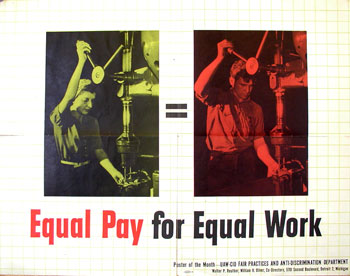
UAW-CIO Fair Practices and Anti-discrimination Department poster c.1950
By Mary Beth Maxwell
Recent headlines reveal what many of us already know — Americans are witnessing the highest inflation rates seen in over 20 years. According to the U.S. Department of Agriculture, food prices climbed nearly five percent in 2007, and as housing and energy costs skyrocket out of control, working families are getting squeezed. In these difficult times, we should also be reminded that women face even greater financial struggles when weathering this economic storm.
With the observance of Equal Pay Day on April 24, we mark how far into each year a woman must work to earn as much as a man did in the previous year. Recent wage data from the Bureau of Labor Statistics does not give cause for celebration. In 2007, women earned only 80 cents for every dollar a man earned. This pay gap was substantially greater for minorities, with African-American women making only 70 cents and Hispanic women making only 62 cents for every dollar earned by their male counterparts. While women are more reluctant to negotiate salaries and are often employed in underpaid professions, one grim reality remains — gender-based discrimination still inherent in our society has largely caused the pay gap that persists today.
Although women can’t always rely on their employer to give them equal pay for an equal day’s work, they can count on union representation to help close the gap. That’s a dirty little secret most employers don’t want their workers to know – just ask educators at the Ithaca City School District in Ithaca, N.Y. In 2002, hundreds of teaching assistants and teacher aides, 90 percent of them female, had a starting pay of only $6.72 an hour. Putting pressure on the school district to end these poverty wages, the educators organized a union and bargained a contract, receiving a 50 percent raise in starting salary to $10.05 an hour. The Bureau of Labor Statistics’ most recent data indicates that when women are members of unions, they make the same pay as men who are not, a clear indication of the benefits unions can provide in helping improve the financial security of women.
At a time when union membership presents us with a chance to narrow the wage gap and move toward greater equality, passage of the Employee Free Choice Act is vital. Set to be reintroduced in Congress next year, the bill will give workers a more direct path to freely and fairly form a union if they so choose. Since employers often resist organizing campaigns with illegal tactics used to intimidate and scare workers, this legislation will also hold anti-union employers accountable for violating federal labor laws through tougher penalties and greater enforcement.
The wages of many working women have already improved thanks to union membership, but even more women stand to gain ground if this proposal is passed. For example, in the retail food industry union members earn 31 percent more than non-union employees. Overall, the employer contribution to health insurance premiums and pension coverage is more than twice as high for union members as for non-union members. By breaking down the barriers workers face when attempting to join a union, the ability of women to reach the American dream through fair and equitable compensation will be heightened.
That is, if lawmakers next year have the conviction to pass the legislation. While the Employee Free Choice Act overwhelmingly passed the House this session, the Republican leadership killed the bipartisan version of the bill in the Senate. Members of Congress will soon have the opportunity to hear from Americans wanting their elected leaders to take another step toward income parity through passage of this legislation. As the cost of rent, gas, health care and other necessities continues to rise, women who often are the sole breadwinners for their families can’t afford another stalemate of this critical bill in Congress next year.
Maxwell is the executive director of American Rights at Work.
